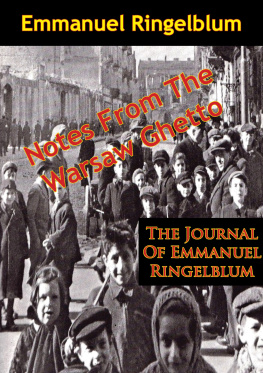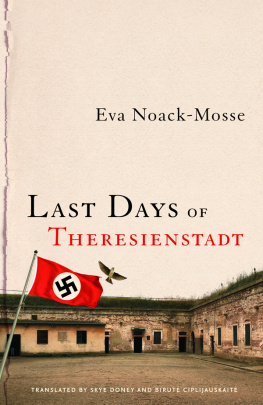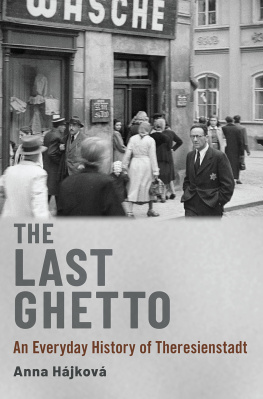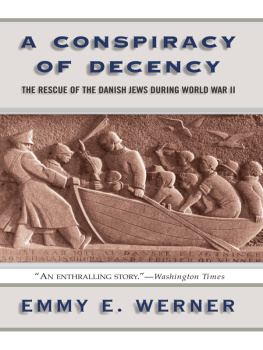The Jews of Denmark in the Holocaust
Based on never previously explored personal accounts and archival documentation, this book examines life and death in the Theresienstadt ghetto, seen through the eyes of the Jewish victims from Denmark.
How was it in Theresienstadt? Thus asked Johan Grn rhetorically when he, in July 1945, published a short text about his experiences. The successful flight of the majority of Danish Jewry in October 1943 is a well-known episode of the Holocaust, but the experience of the 470 men, women, and children that were deported to the ghetto has seldom been the object of scholarly interest. Providing an overview of the Judenaktion in Denmark and the subsequent deportations, the book sheds light on the fate of those who were arrested. Through a micro-historical analysis of everyday life, it describes various aspects of social and daily life in proximity to death. In doing so, the volume illuminates the diversity of individual situations and conveys the deportees perceptions and striving for survival and normality.
Offering a multi-perspective and international approach that places the case of Denmark in the broader Jewish experience during the Holocaust, this book is invaluable for researchers of Jewish studies, Holocaust and genocide studies, and the history of modern Denmark.
Silvia Goldbaum Tarabini Fracapane holds a PhD in Modern History from Technical University Berlin and an MA in Comparative Literature from University of Copenhagen.
Routledge Studies in Second World War History
The Second World War remains today the most seismic political event of the past hundred years, an unimaginable upheaval that impacted upon every country on earth and is fully ingrained in the consciousness of the worlds citizens. Traditional narratives of the conflict are entrenched to such a degree that new research takes on an ever important role in helping us make sense of World War II. Aiming to bring to light the results of new archival research and exploring notions of memory, propaganda, genocide, empire and culture, Routledge Studies in Second World War History sheds new light on the events and legacy of global war.
Recent titles in this series
British Exploitation of German Science and Technology, 19431949
Charlie Hall
Unknown Conflicts of the Second World War
Forgotten Fronts
Chris Murray
A New Nationalist Europe Under Hitler
Concepts of Europe and Transnational Networks in the National Socialist Sphere of Influence, 19331945
Edited by Johannes Dafinger and Dieter Pohl
The Swedish Jews and the Holocaust
Pontus Rudberg
The Jews of Denmark in the Holocaust
Life and Death in Theresienstadt Ghetto
Silvia Goldbaum Tarabini Fracapane
For more information about this series, please visit: https://www.routledge.com/Routledge-Studies-in-Second-World-War-History/book-series/WWII
First published 2021
by Routledge
2 Park Square, Milton Park, Abingdon, Oxon OX14 4RN
and by Routledge
52 Vanderbilt Avenue, New York, NY 10017
Routledge is an imprint of the Taylor & Francis Group, an informa business
2021 Silvia Goldbaum Tarabini Fracapane
The right of Silvia Goldbaum Tarabini Fracapane to be identified as author of this work has been asserted by her in accordance with sections 77 and 78 of the Copyright, Designs and Patents Act 1988.
All rights reserved. No part of this book may be reprinted or reproduced or utilised in any form or by any electronic, mechanical, or other means, now known or hereafter invented, including photocopying and recording, or in any information storage or retrieval system, without permission in writing from the publishers.
Trademark notice: Product or corporate names may be trademarks or registered trademarks, and are used only for identification and explanation without intent to infringe.
British Library Cataloguing-in-Publication Data
A catalogue record for this book is available from the British Library
Library of Congress Cataloging-in-Publication Data
A catalog record has been requested for this book
ISBN: 978-0-367-19502-1 (hbk)
ISBN: 978-0-429-20282-7 (ebk)
Typeset in Bembo
by codeMantra

Lydia Frankensteins star from Theresienstadt
Theresienstadt. That my sister, Klara Nathan, Krystalgade 12, Copenhagen, took her own life out of grief. My sister-in-law, Mrs Rebecca Wattkin, born Nathansohn, Copenhagen, Ny Kongensgade 8 2. floor died of hunger and distress. Sorrow and distress for 1 year, and hard work and dirt, and fleas and bedbugs were worst for us all. I myself lost in weight during 4 months (23 kilos). If the Red Cross had not helped, I and my family would absolutely all have died of hunger, sickness and filth. I could write an entire book about the stay in Theresienstadt. The saddest experience we had, was to see children drag the ashes of 35 thousand deceased into cars, which afterwards drove away with the ashes, also from my two relatives. Then I cried.
Rudolf Nathansohn, late April 1945
In the quarantine camps in Sweden in late April 1945, a number of Danish Theresienstadt survivors responded to a call for testimonies from the World Jewish Congress (WJC). This contrasts with conditions as described in the testimonies of the Danes, which show that, despite the privileges, the 18 months in the ghetto represented a shocking and brutal encounter with life behind barbed wire which marked them for the rest of their lives.
In Sweden, in May 1945, some Danish survivors were interviewed by newspapers about their stay in the ghetto.
Some survivors later spoke about feeling rejected when, shortly after liberation, they began to tell friends or school mates about Theresienstadt. They were soon interrupted and told, more or less sensitively, that the listener had heard enough.
In spite of the testimonies, the points of views of the Danish survivors went largely unincorporated into the national narrative about October 43.
Historians have paid only cursory attention to the Jewish deportees and their experiences, whereas October 43 has been analysed and described from almost all other perspectives. The specific circumstances surrounding the successful escape of the majority of Danish Jewry have been studied in detail, focussing, first and foremost, on the flight itself and the people involved.
Danish Theresienstadt testimonies
This work is based on a study of written and oral sources from 146 named Danish Theresienstadt survivors, many of whom have given multiple testimonies. The deportees from Denmark in Theresienstadt included 223 girls and women, of whom 194 survived, and 247 boys and men, of whom 224 survived. I have located written or oral sources from 59 female survivors and 87 male survivors. To give an overview of the vast and varied collection, I will briefly present the sources on the following pages. These testimonies were created between 1943 and 2017, a time span which can be broken down into five periods, as follows.
Real-time sources: 19431945
Eyewitness accounts in the form of diaries, notebooks, and notes were written in the ghetto. Among these documents are three longer diaries, all written by men. Ralph Oppenhejm (19242008), the youngest of the diarists, came from an old Danish Jewish family and was deported with his parents and a younger sister. He kept a diary from March 11, 1944, until after liberation, which ends on June 7, 1945.









